
 |
|
|
#1 |
|
Member
Join Date: Oct 2005
Location: Boston, MA
Posts: 21
|
I bought this dadao about 4-5 years ago (the second sword in my then nascent collection). As far as I can tell, it is typical of civilian dadao used in China during the Boxer Rebellion and subsequent Republican era, so turn of the 20th century to 1940's. It is a fairly large piece 28.5in in blade length, 10in from pommel to guard of insert edge construction. The fullers, called xue cao in Chinese (which interestingly enough translates to blood grooves) were roughly added into the piece. Because of the lack finese in the manufacture of the fullers, it is tempting to think if they were added latter in the life of this blade. However, the state of oxidation in the fullers were consistent with the rest of the blade. At the forte is a flower motif on one side, and engraved characters (nan giang he cun) on the other. Nan = South, qiang = strength, He Cun = is a village name.
  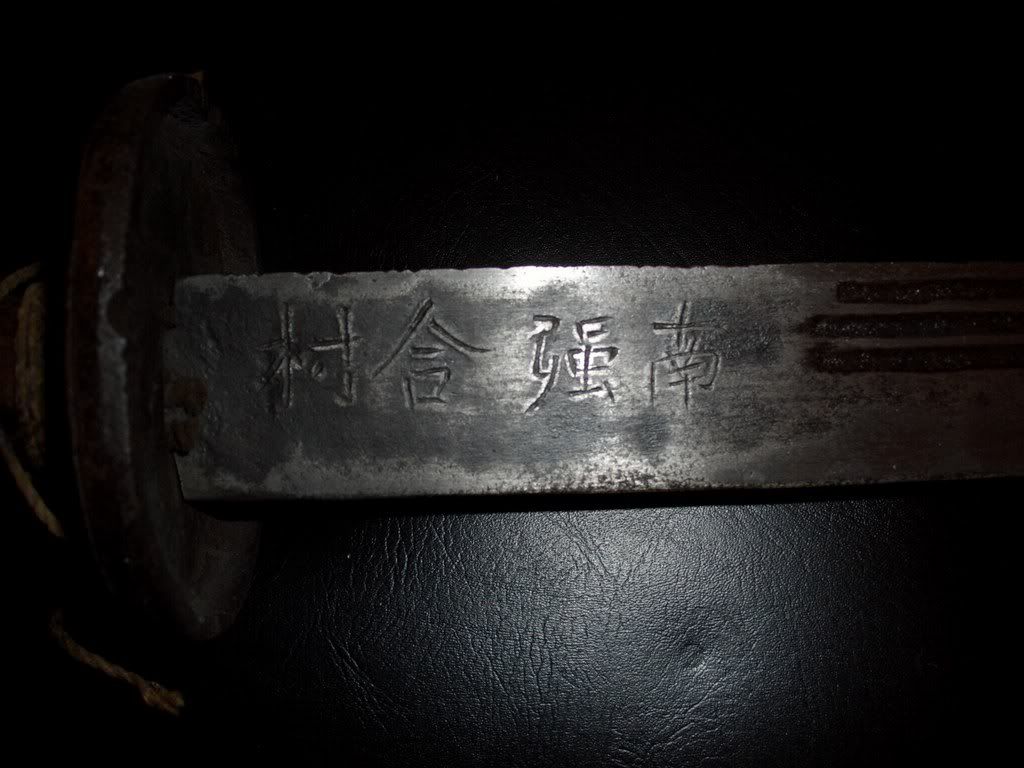 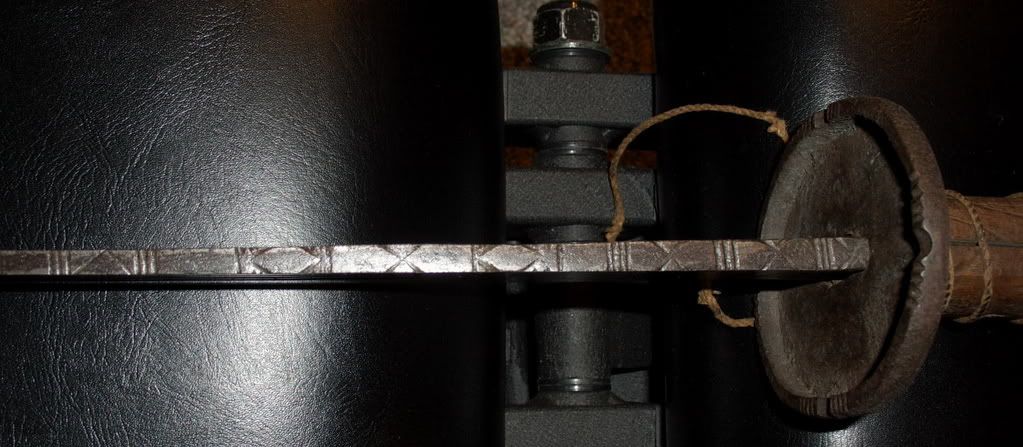 I actually posted this piece about 3 years ago: http://www.vikingsword.com/vb/showthread.php?t=1548 I bought it intending to polish it myself but never had the time and as it turns out, won't have for the next few years. A quick window polish showed some typical, but to me, interesting pattern-welding. This quality of the piece didn't justifying asking Philip Tom to take a look at it, but I decided to ask a fellow collector, William Reinman who had shown a lot of talent restoring a niuweidao and jian purchased from Scott Rodell to take a crack at it (threads in SFI). |
|
|

|
|
|
#2 |
|
Member
Join Date: Oct 2005
Location: Boston, MA
Posts: 21
|
I recently got the piece back from William and I though he did a tremendous job bringing out the inner beauty of this "rustic" fellow. There are some areas of scratching were previous lower grits weren't completely removed, but as can be seen by the pictures below, the blade came out beautifully. We decided to re-wrap the handle with new red cord. While I'm not certain what the original coloring of the cord was, the few intact pieces of this style I have seen tended to have red cord.
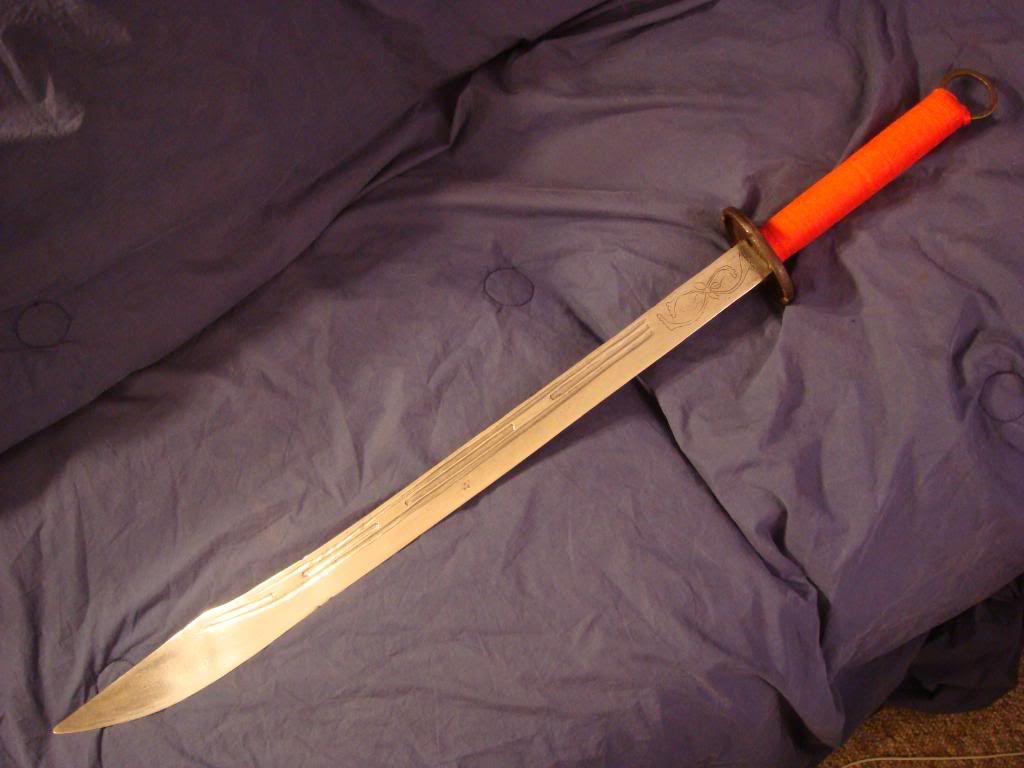  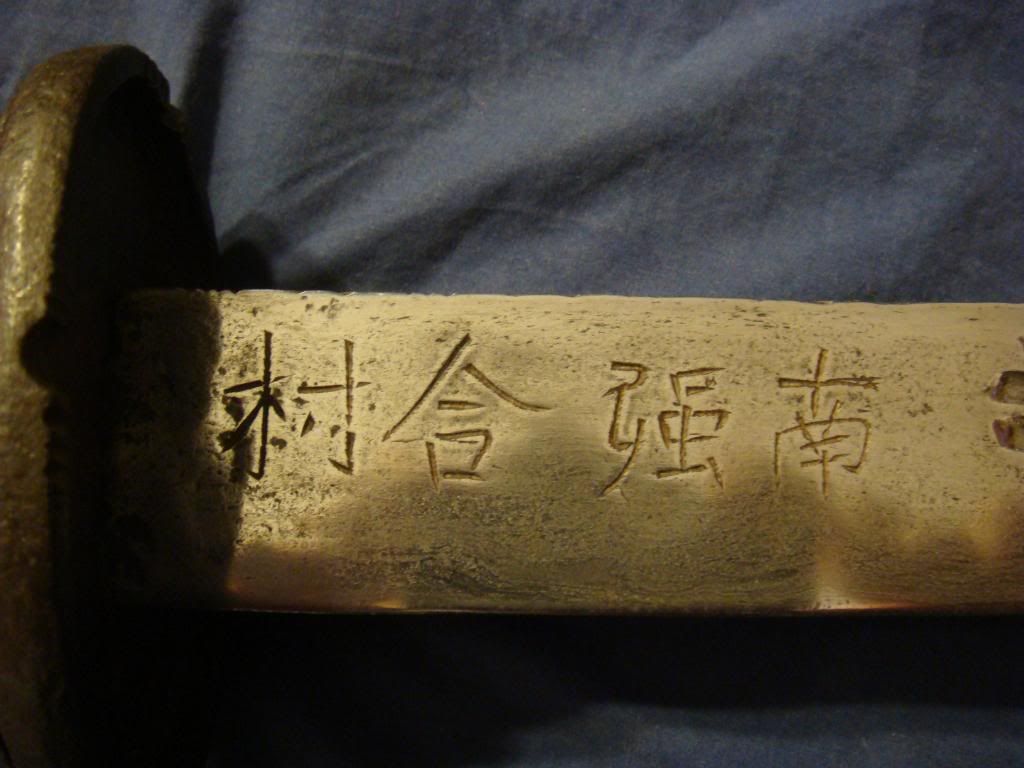 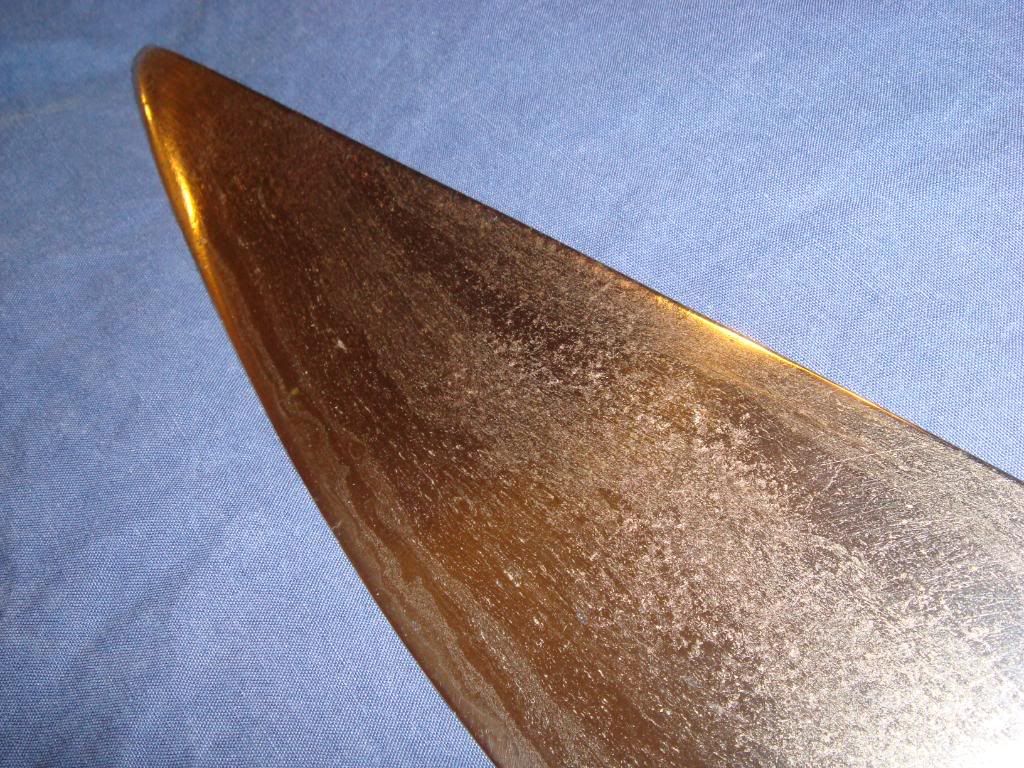
|
|
|

|
|
|
#3 |
|
Member
Join Date: Oct 2005
Location: Boston, MA
Posts: 21
|
More pictures:
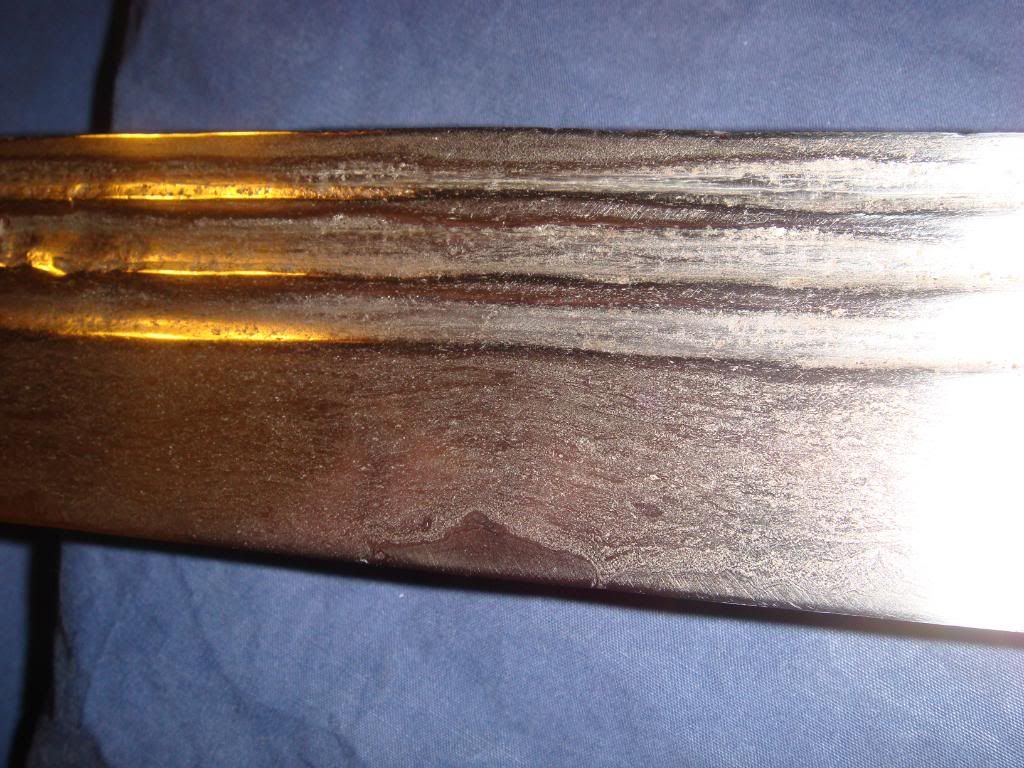 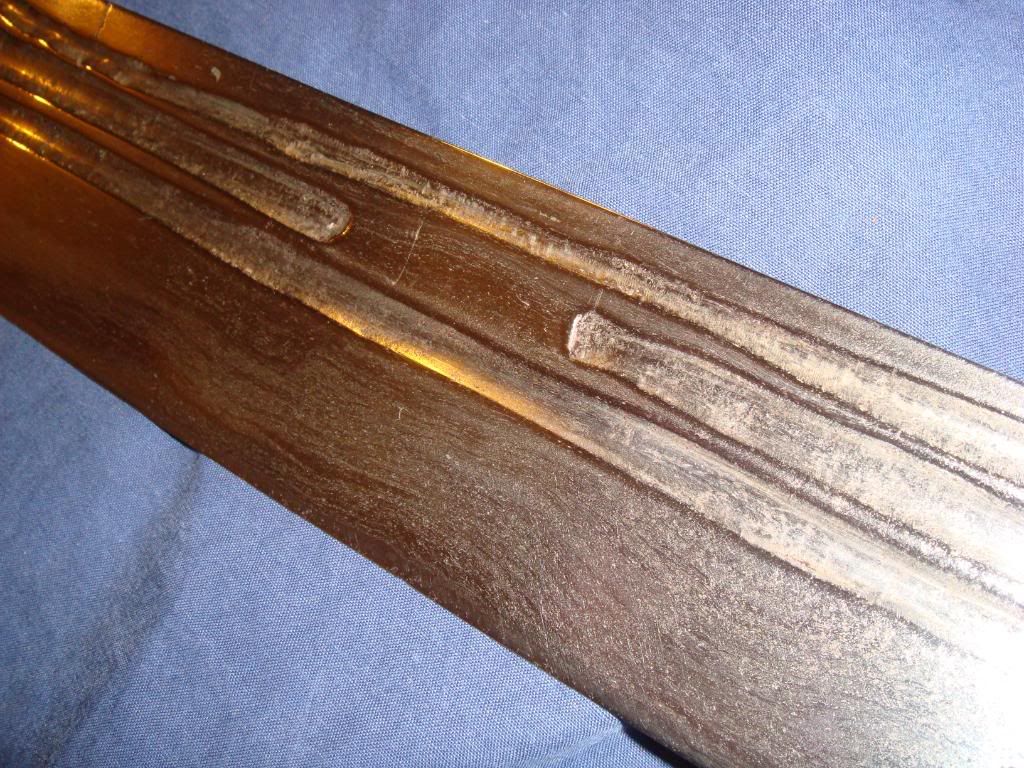  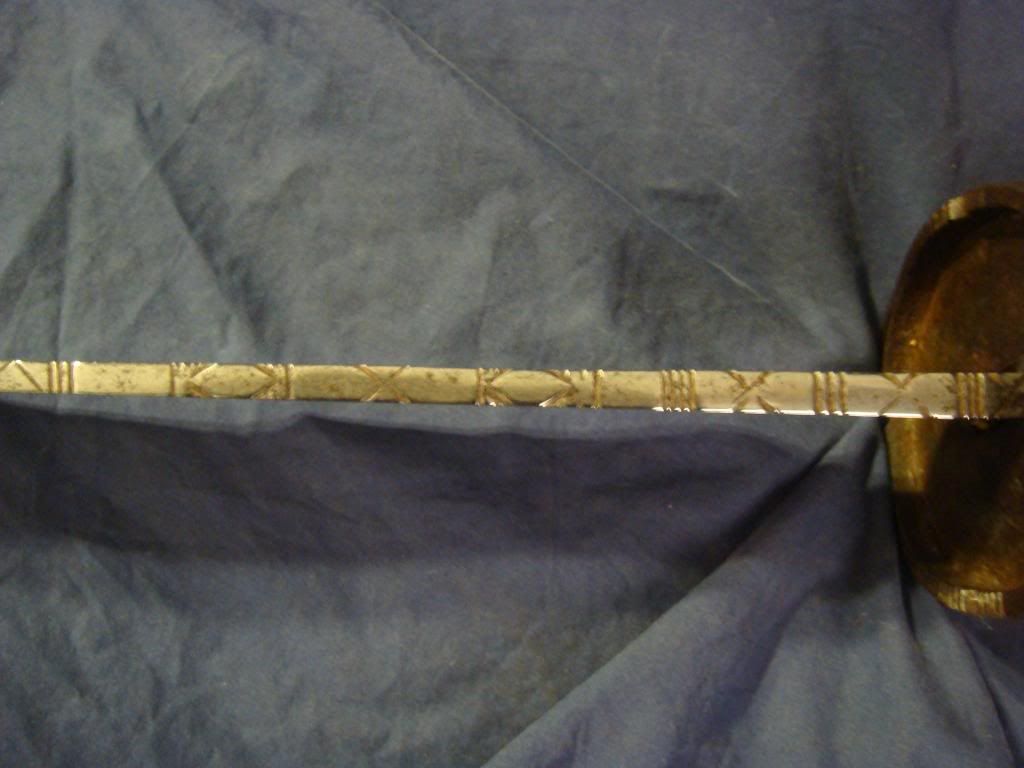 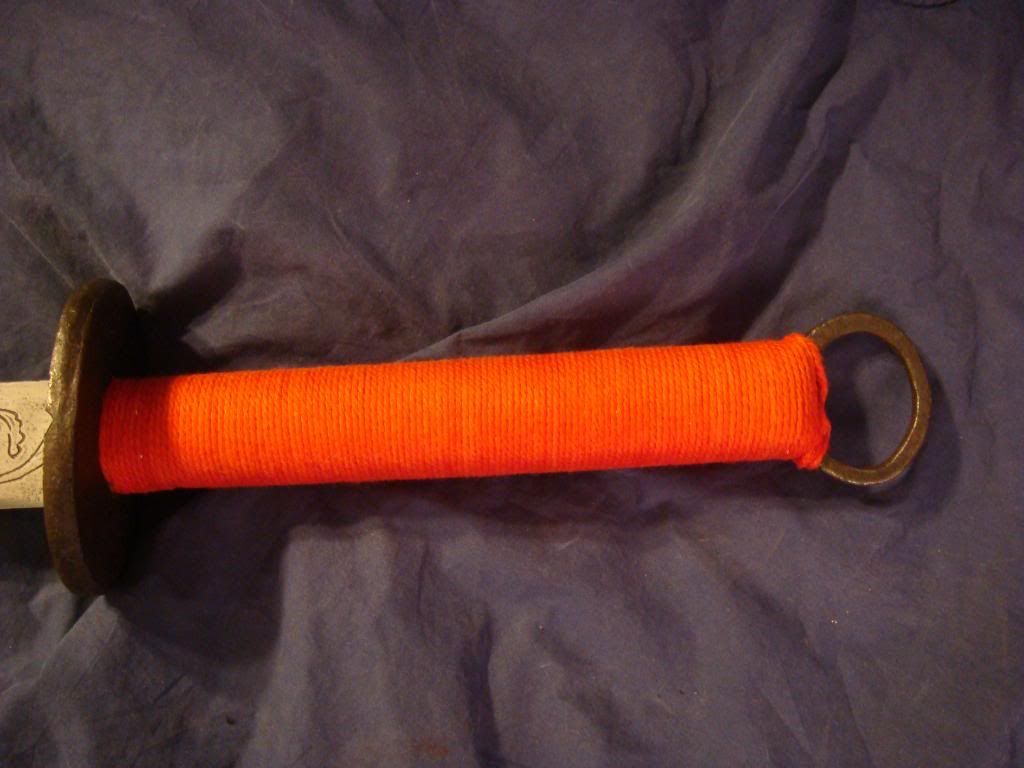
|
|
|

|
|
|
#4 |
|
Member
Join Date: Jun 2008
Location: The Sharp end
Posts: 2,928
|
Hi YMC
I think it looks great! And most importantly it is once again as it should be. A sword should be usable. I'd be interested in seeing pictures in daylight or with no flash also. Congratulations Gene |
|
|

|
|
|
#5 |
|
Member
Join Date: Dec 2004
Location: Ann Arbor, MI
Posts: 5,503
|
I disagree.
Cleaning and etching the blade is fine, but it was a pretty easy task to find a matching thread and finish the wrapping unobtrusively. The new orange nylon looks absolutely foreign and screamingly new. The sense of history is lost. |
|
|

|
|
|
#6 |
|
Member
Join Date: Aug 2006
Location: Heidelberg, Germany
Posts: 182
|
I totally agree with ariel. In my opinion, an old weapon deserves to look like an old weapon - polishing the blade is fine, but the original handle was not so damaged that it had to be removed completely. Now you have a historical weapon that looks like a modern souvenir...
 Sorry for being impolite, it's just my opinion. Peter |
|
|

|
|
|
#7 |
|
Member
Join Date: Jun 2008
Location: The Sharp end
Posts: 2,928
|
I do agree the colour does look very new, but its easy enough to change if needed, replace completely or tone down. I would personally have gone for a dark colour, but it's personal preference.
P.S. My poor Dao is still awaiting restoration and the handle is bound with thick string painted black! 
|
|
|

|
|
|
#8 |
|
(deceased)
Join Date: Dec 2004
Location: East Coast USA
Posts: 3,191
|
Lovely blade but the wrap must go. It just doesn't blend
 you should see if someone hear can do a traditional Chinese style wrap. You should contact Scott he may be able to help. you should see if someone hear can do a traditional Chinese style wrap. You should contact Scott he may be able to help.http://www.sevenstarstrading.com/ Lew |
|
|

|
|
|
#9 |
|
Member
Join Date: Oct 2005
Location: Boston, MA
Posts: 21
|
Thanks for the honest and constructive comments from everyone. First, I have to take responsibility for the choice of the red cord; William had wrapped it with a beige cord. While the original old cord is certainly beige now, I thought I saw areas of "pink" which suggested that the original color was more reddish. As I stated, I had at least one other example of a similar dadao (which I gave to my sifu so I can take some pictures of it soon) which has it's original red cord wrap (faded with time of course). The wrap had interwoven red cloth bands on each side of the handle. Based on that and others, it would suggest that the color red is not at all unhistoric.
However, I can certainly see everyone's point, the color and newness of the wrap is jarring now that people are noting it. Even if I replace the wrap, I would probably want to attempt to "age" it a bit. Any suggestions or techniques that have worked well for you? Lew, thanks for the suggestion to talk to Scott. I actually have used someone, via Philip Tom, for previous traditional Chinese wraps so it may well be worth it to talk to them about this piece. Gene, I'll try to take some pictures with proper lighting and no flash soon, just haven't had the time to set it all up. Yu-Ming Last edited by Yu-Ming Chang; 6th January 2009 at 05:10 AM. |
|
|

|
|
|
#10 | |
|
Member
Join Date: Oct 2007
Posts: 2,818
|
Quote:
I see the hilt wrappings have  shocked shocked  most here and I am happy that you are making the effort to replace the wrap. most here and I am happy that you are making the effort to replace the wrap.I beleive if you see pink in the old beige cord that it was probably beige to begin with but dyed to obtain the red in it's former life. I have attached an image of the ring pommel and wrapping on mine to show the original flat cord used that the red is still present under the wrapping in places that is now "bleached" over time with use and the elements. Please find nice flat wrapping, enough to do a few swords and experiment with some red dye. Gav Gav |
|
|
|

|
|
|
#11 |
|
Member
Join Date: Dec 2004
Location: California
Posts: 1,036
|
It's interesting to note how the lamellar structure of the blade shows a controlled and rather attractive undulating pattern, indicating that the smith took the time to do a decent forging job, and yet the fullers wander drunkenly to and fro. Yet, considering that these weapons were for the most part the products of village smithies, or the makers of domestic knives and tools, it's not that hard to understand. The art of cutting long channels into blade surfaces is a skill that a swordsmith would be expected to practice, but an artisan who makes farm implements or carpenters' tools would have little opportunity to use such techniques. I have a large carpenter's adze, probably late Qing, whose blade shows considerable skill in lamellar forging and localized heat treating, but it's not the sort of thing that requires knowledge of fullering.
Regarding the cord: The color looks more orange than red in the photos, but don't know if that's due to the effect of the flash. Be that as it may, this is something that can easily be replaced, if desired, with something of a more suitable color. It's worth mentioning that it's also important what the cord material is. If it's a synthetic material, of course it should go. But if it's a cotton or hemp-based fiber, at least the material is historical and the color of the existing wrap can be adjusted and "antiqued" if replacement is not desired. These dadao hilts were originally wrapped in a variety of materials: thick twine-like cord, narrow strips of thick cloth (called "bias tape" in the tailoring trade) in a basketweave pattern, and even split rattan (common on Vietnamese examples). Colors can vary: natural fiber (varying shades of brown), cord dyed or lacquered red or black, cloth tape with dark red and green interwoven, etc. So there's no one material, style, or color that's appropriate. So long as you don't try to use nylon parachute cord when restoring your hilt! A natural fiber can easily be dyed. I've used good quality leather dyes with good effect (they make great wood stains as well), they come in a variety of shades, are available in smaller sized bottles, and the colors are blendable. Fiebing's is a good brand, I've purchased this product from Jantz Supply in Davis, OK (www.knifemaking.com) The mahogany shade is an attractive dark reddish-brown that is appropriate. (YOU CAN MAKE A LIGHTER COLOR BY POURING SOME OF IT INTO A BOWL OR JAR, AND ADDING ALCOHOL -- EXPERIMENT TIL YOU FIND A SHADE YOU LIKE). A shoemaker's shop might be the source for other colors, in case you want to opt for a deep vermillion red. Apply with a dauber or brush until the color is uniform, and let dry overnight. Then wipe strenuously with a discarded piece of towel to remove excess pigment. You can add a sheen of age to the dry surface by rubbing in some Johnson's paste-type furniture wax, and buffing with the same brush you use to shine your shoes. The residual shoe polish in the brush will darken the high spots, simulating the oils that gets rubbed into the surface after years of handling. If you want more of a "Long March veteran" look to it, practice your dadao form with the weapon just after you finish cleaning your BBQ grill. |
|
|

|
|
|
#12 |
|
Member
Join Date: Dec 2004
Posts: 1,247
|
Hi All,
I'm enjoying this, as I have a couple of modern dao blades that I want to properly hilt some day (the hilts they came with were junk). Question on the flat wrap: to my eye it looks like a simple three-ply braid. If so, you can manufacture as much as you want by getting appropriate cord and braiding away (or asking a child of your acquaintance to do it for you). One question: how is that ring pommel attached to the handle? Best, F |
|
|

|
|
|
#13 | |||
|
Member
Join Date: Oct 2005
Location: Boston, MA
Posts: 21
|
Quote:
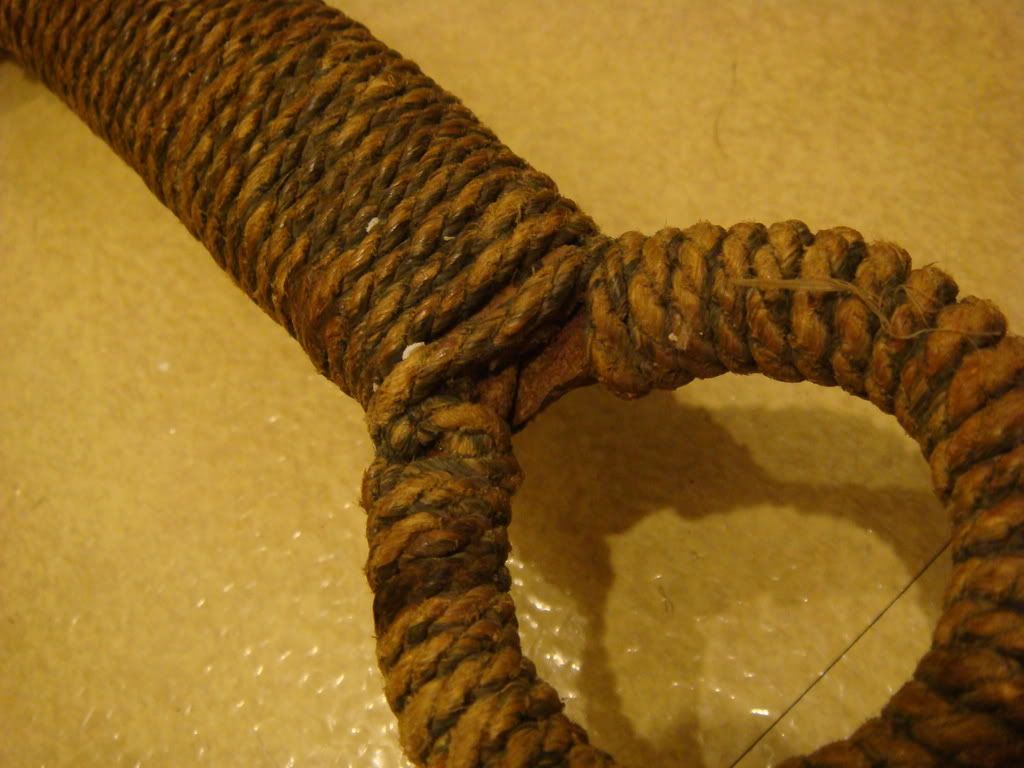 Quote:
Quote:
 When I start experimenting with the wrap, I'll post some follow up to get further input to see if I'm getting things right. Yu-Ming Last edited by Yu-Ming Chang; 6th January 2009 at 10:31 PM. |
|||
|
|

|
|
|
#14 |
|
Member
Join Date: Oct 2007
Posts: 2,818
|
Hi Fearn,
I have only ever seen one old dao without the wooden hilt and the ring pommel was actually part of the tang, extended all the way and doubled back just like a long hair pin so to speak, mayhap this was a one of a kind and they are attached differently but that's all I know. Well there you go, looks like a posted a nano second after Yu-ming. There is a good example, slightly different from what I have seen. Yu-Ming, do you have any images of you dao's hilt prior to re-wrapping, they may show the ring pommel arrangement better? Gav |
|
|

|
|
|
#15 | |
|
Member
Join Date: Oct 2005
Location: Boston, MA
Posts: 21
|
Quote:
I didn't take any pictures of the hilt prior to re-wrapping, but I'll take some when I start experimenting with re-re-wrapping. Yu-Ming |
|
|
|

|
|
|
#16 |
|
Member
Join Date: Oct 2005
Location: Boston, MA
Posts: 21
|
Fearn and Gav,
I just remembered a piece that I have in my collection where the ring pommel was made separately and then lap-welded on the tang. 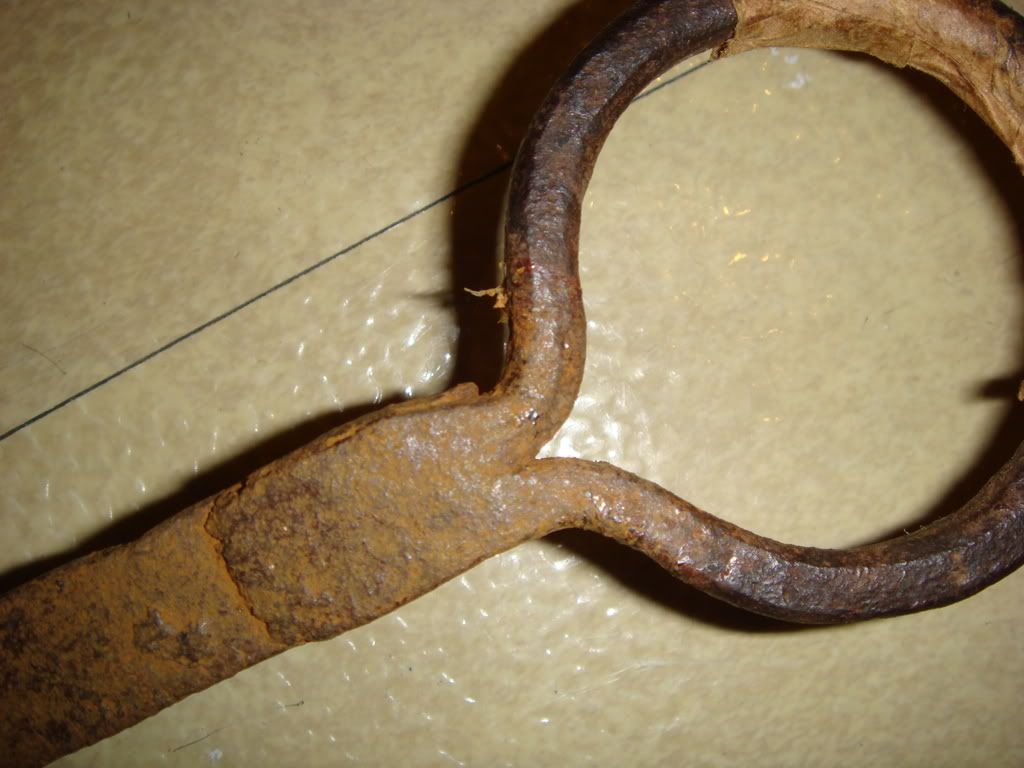 Yu-Ming |
|
|

|
|
|
#17 |
|
Member
Join Date: Oct 2005
Location: Boston, MA
Posts: 21
|
While I haven't had time to antique up the cord wrap on the dadao I had restored, I did have a chance to take some pictures of a Republican era dadao I once owned with its intact original wrap. The red cord wrap is somewhat faded and darkened with grease and oil from use. The interwoven bands are of cord, not cloth strips as I remembered. In any case, I thought a look at an original wrap from a 50-60 year piece might be of interest to some of us.
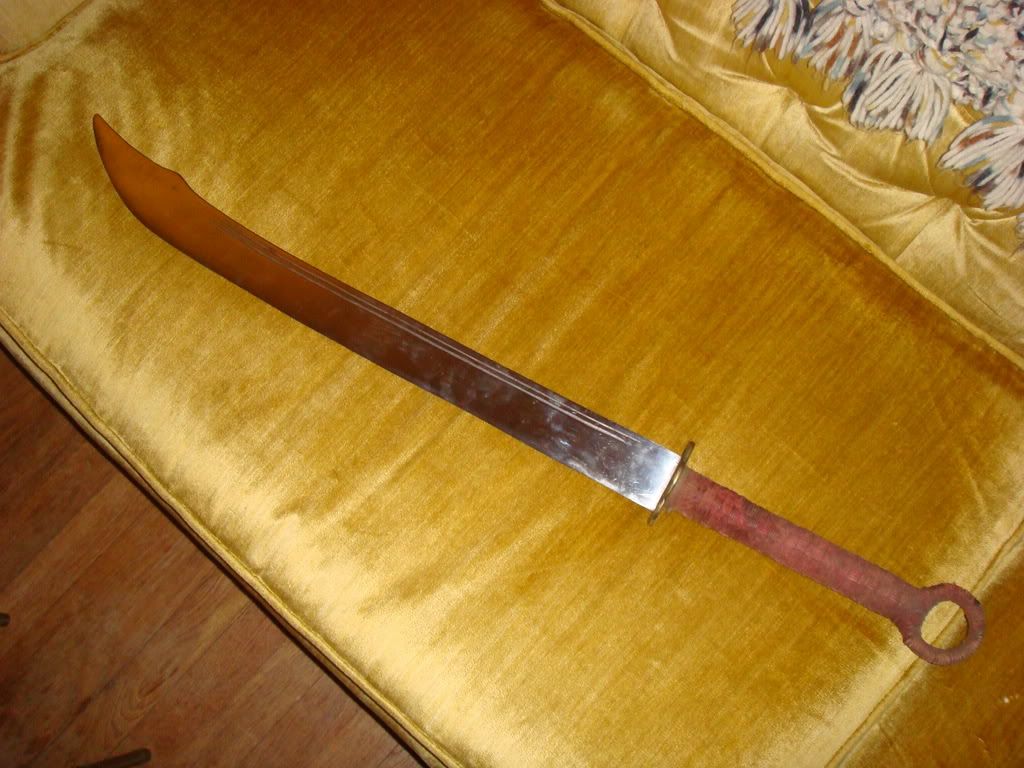 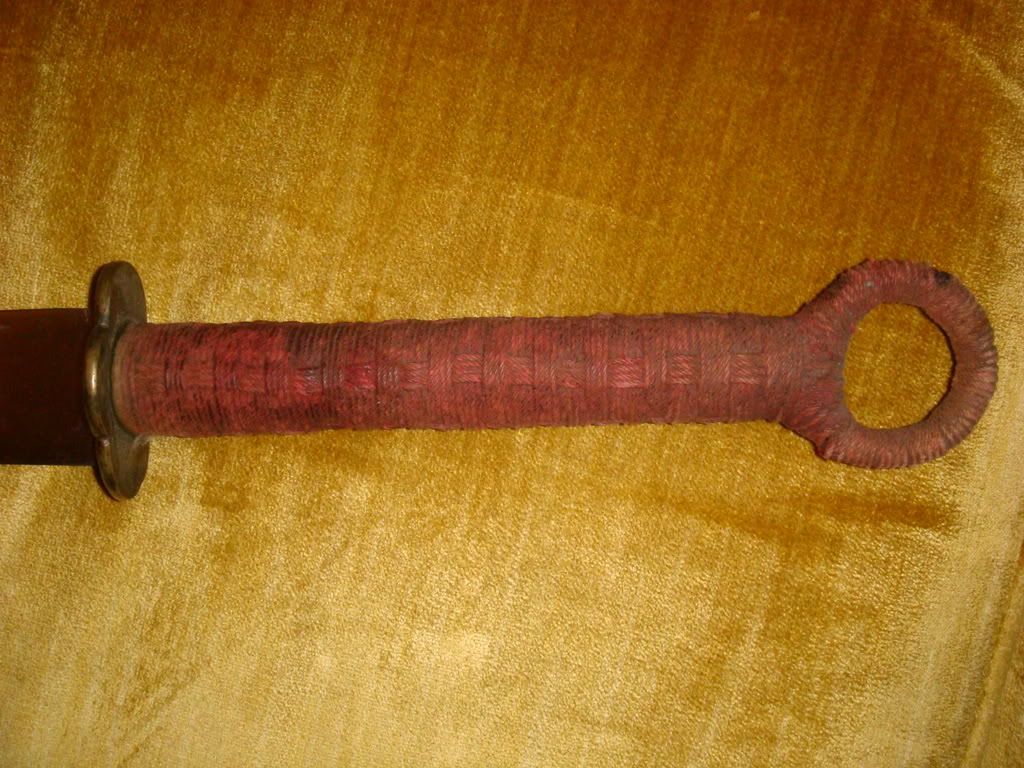 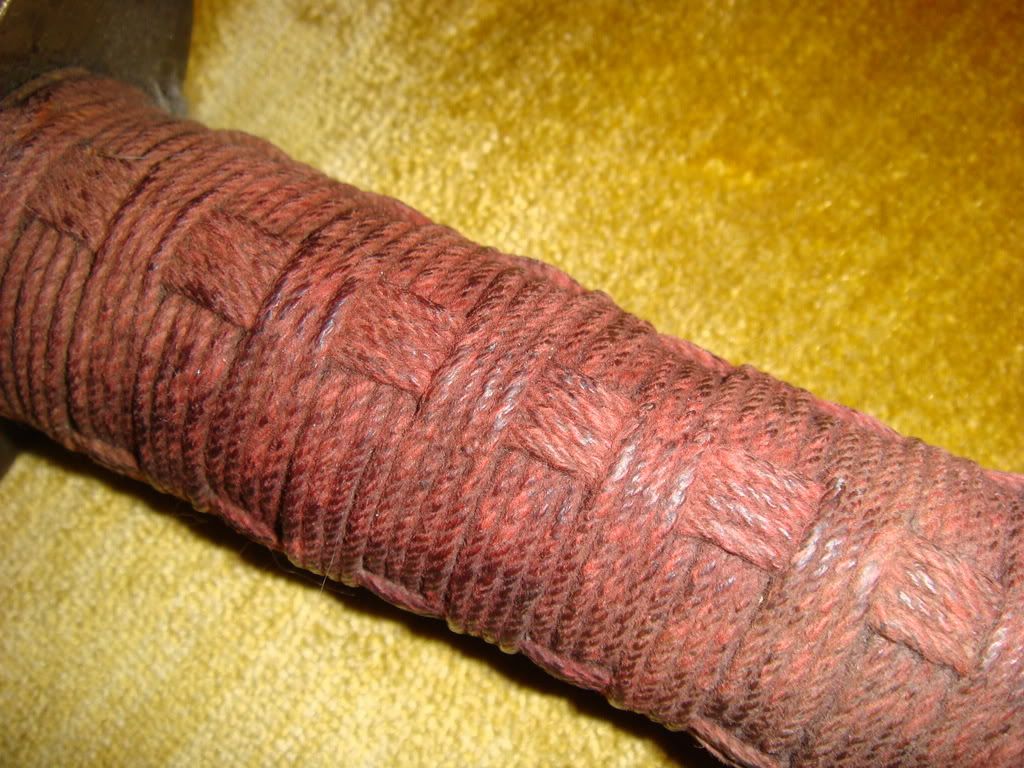
|
|
|

|
|
|
#18 |
|
Member
Join Date: Dec 2004
Location: California
Posts: 1,036
|
Hi, Yu-ming
That's a nice example, with a clean blade that appears to be of nice quality for one of these, and intact cord wrapping with mellow fading and lovely patina. Great to find one of these whose grip covering isn't all ratty and chewed up. The style of the wrapping (a simple spiral with four longitudinal "basketweave" strips) is quite common on dadao. On occasion, the longitudinal bands are cloth strips, not cord. Red on red is most often seen, although I've run into red and green, red and white, etc. As I've stated in a previous post, the material seen more often in Vietnam is split rattan, or a heavy twine that is twisted from sisal or similar plant fiber. |
|
|

|
|
|
#19 |
|
Member
Join Date: Aug 2009
Posts: 338
|
The more I look into chinese ethnographic blades the more interested I get. Does anyone have any more Dadao they care to share with us?
|
|
|

|
|
|
#20 |
|
Arms Historian
Join Date: Dec 2004
Location: Route 66
Posts: 9,945
|
I agree, these are most interesting, and as traditional weapons used in the civilian martial arts sector they remained basically the same for countless generations. These were long in use by the time of the Boxer Rebellion, and as Philip noted years ago here, they were often products of village smiths.
Recalling the grip thread color, I agree with using the more subdued color or even keeping the old if it wasn't coming off. I would note that during the Boxer Rebellion martial artists often used these and other forms of the ring pommel chopper in dramatic martial exercises and displays. As I have understood, these swords were sometimes garishly festooned to add to the dramatic effect and ostensibly to terrify onlooking westerners. Still, I would not personally one of these to regain that theoretical, or should say theatrical, appearance. The grease and oil mentioned in the earlier post was likely from the preservative grease often used when these were stored away, and may suggest a 'bringback' item from the Boxer Rebellion period. Additional note, aren't the 'chop marks' and 'x' marks on the back of the blade as often seen on SE Asian dhas and some other Asian areas? I know I have seen similar on Laotian dhas. Perhaps the dao with these may have seen service in Chinese occupied regions in SE Asia? |
|
|

|
|
|
#21 |
|
Member
Join Date: Jan 2012
Posts: 406
|
You could try leaving it on a sunny window-sill if you want to "bleach" some of the colour out of the wrapping', just be careful it doesn't dry out too much and become brittle.
Regards Richard |
|
|

|
|
|
#22 |
|
Member
Join Date: Oct 2008
Location: between work and sleep
Posts: 731
|
Yu-Ming Chang, that's a very nice piece. A lot of old Da-dao are in much worse shape. Glad to see there's another lover of classic Chinese weaponry in the Boston area!

|
|
|

|
|
|
#23 |
|
Member
Join Date: Jan 2005
Posts: 38
|
Hi Thepepperskull you inquired if anyone had any Chinese da-dao to share, I have about 200 of them mostly in poor condition. Hi KukulzA28 I'm also in the Boston area so one more lover of da-dao here.
Best, Maskell Jerry |
|
|

|
|
|
#24 |
|
Member
Join Date: Dec 2004
Location: Ann Arbor, MI
Posts: 5,503
|
In the lower pic, the 3rd from the right: how often do you see this type of crossgurad ( snail-like), and is it in any way indicative of age, location, quality etc. ?
|
|
|

|
|
|
#25 |
|
Arms Historian
Join Date: Dec 2004
Location: Route 66
Posts: 9,945
|
On the 'snail like' crossguard....if I recall correctly it is similar to the jian like guards seen on early kora from Tibetan regions (I think early 18th century and think one is seen in Stone). I think this of course suggests possible far western Chinese frontier use....speculation of course.
Maskell, impressive (and huge!) grouping of these swords......with this number of examples have you worked on any developmental arrangement with variations or possibly other indicators in identification? It would be fascinating to know more!! For me ,condition is irrelevant but learning from these examples would be extremely valuable. |
|
|

|
|
|
#26 |
|
Member
Join Date: Mar 2010
Location: Wisconsin
Posts: 109
|
The "rams horn" guard seems to be a rather common guard form. As far as indicative of a a region, I have some that I know were collected in Northern China (Shandong, Shanxi). Although I do not think they were exclusive to this area. In relation to quality, I have seen this form on working class service pieces generally speaking. I believe my examples to be Qing era.
Last edited by Neil; 10th July 2012 at 03:38 PM. |
|
|

|
|
|
#27 | |
|
Member
Join Date: Oct 2008
Location: between work and sleep
Posts: 731
|
The antique Da-Dao I have seen in Taiwan seem to have curled guards, S-guards, and "cup" guards in roughly equal proportion... but WW2 Da-Dao seem to be stereotypically S-guarded...
Quote:

|
|
|
|

|
|
|
#28 |
|
Member
Join Date: Dec 2004
Location: Ann Arbor, MI
Posts: 5,503
|
Here is mine, recently acquired.
The fullers are perfectly executed, the wrapping cord is flat and original, with wooden cheeks underneath. The blade rings like a bell. I am gently removing the crud. Surprisingly, there is very little pitting, just a couple of superficial and very small spots. I do not want to shine it bright: its wrinkles make me feel being on the same page...... Will ve very grateful for any comments. |
|
|

|
|
|
#29 |
|
Member
Join Date: Dec 2004
Location: Ann Arbor, MI
Posts: 5,503
|
Continued......
|
|
|

|
|
|
#30 |
|
Member
Join Date: Dec 2004
Location: Ann Arbor, MI
Posts: 5,503
|
Even with very incomplete cleaning I seem to be able to see laminated structures.
|
|
|

|
 |
|
|